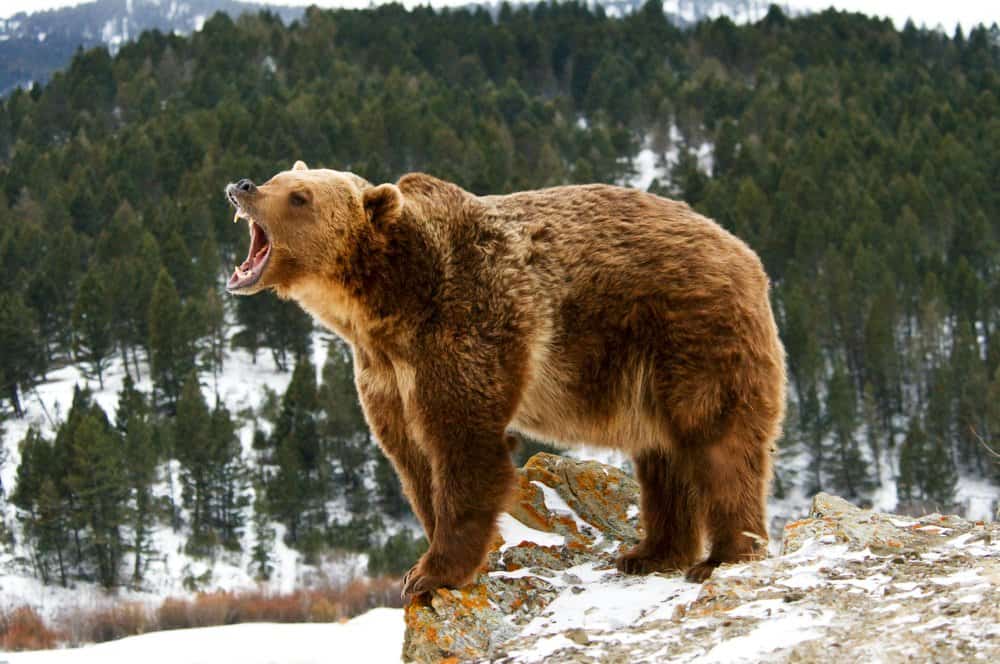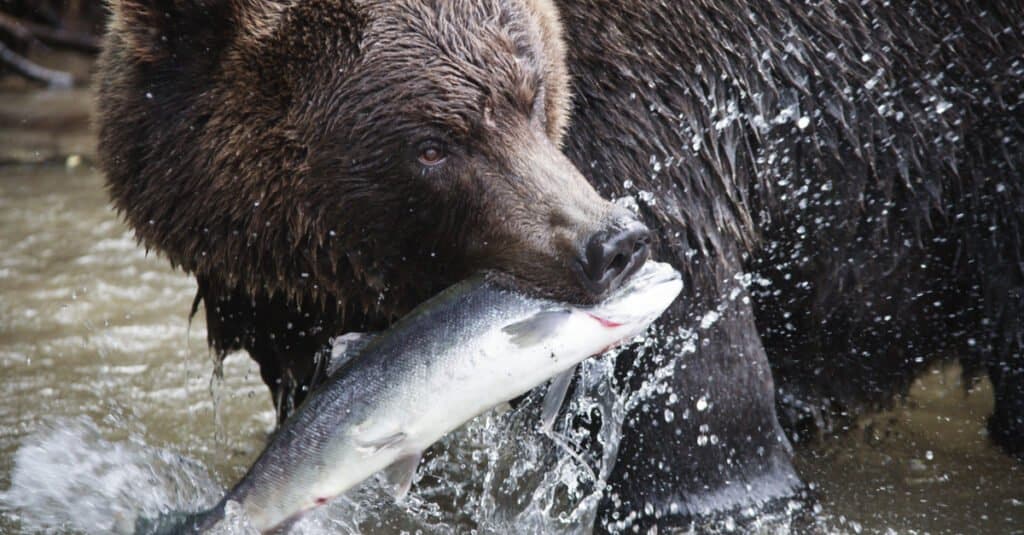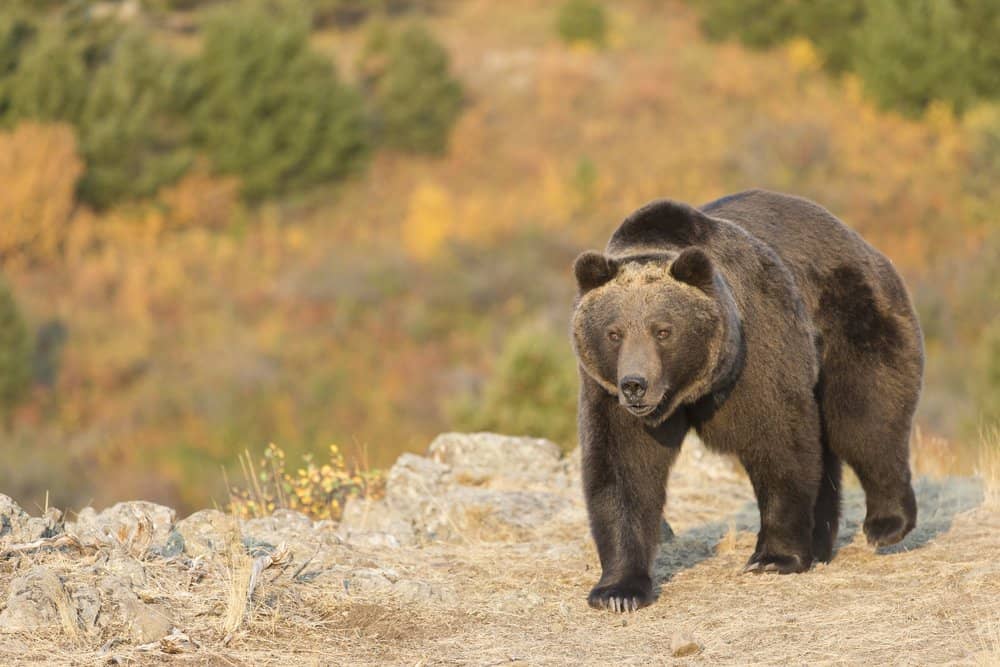In 2019, Arizona’s Center for Biological Diversity filed a lawsuit against the U.S. Fish and Wildlife Service for not having updated a recovery plan for grizzly bears in the state. The Center for Biological Diversity has accused the FWS of violating the guidelines established by the Endangered Species Act.
If you’re not familiar with environmental writing and the politics surrounding this hot topic, don’t worry. We’re going to walk you through everything you need to know to help better understand this subject.
What is the Endangered Species Act?

Grizzly bears are one of the largest species of bear.
©Scott E Read/Shutterstock.com
The Endangered Species Act is a law that helps protect endangered plant and animal species in the United States. However, it goes beyond establishing general protection to also include a section about establishing recovery plans for endangered species.
The reason that the Center for Biological Diversity is suing the U.S. Fish and Wildlife Service is that they have not updated the recovery plan for the grizzly bear. In fact, the last time it was updated was nearly thirty years ago.
While the population of grizzly bears has improved, it’s not yet perfect. The population of grizzly bears in the United States continues to face a variety of threats. This is one of the main reasons that conversations about updated recovery plans have resurfaced.
History of Grizzly Bears
Grizzly bears have a long history in the United States – one even longer than the history of the United States itself. Historically, grizzly bears lived in a variety of areas across the west coast.
However, after over a century’s worth of westward expansion and urbanization, this is no longer true. Now, grizzly bears are only found in a small area. This includes the states of Washington, Wyoming, Idaho, and Montana. While the population has managed to triple since the Endangered Species Act was first established, the conversation isn’t over. Even today, there’s still the question of whether or not to reintroduce the grizzly bear to historical habitats like Arizona and areas surrounding the Grand Canyon.
The Reintroduction of Grizzly Bears in the Grand Canyon

Grizzly bears have a diverse diet.
©DPS/Shutterstock.com
When you think of the Grand Canyon, you may not think of grizzly bears. However, prior to their loss of habitat, grizzly bears could be found across the west, including in Arizona.
And now, scientists and environmentalists alike are trying to decide whether to reintroduce these apex predators to the ecosystem. This is a phenomenon known as a tropic cascade.
What is Trophic Cascade?
When talking about the reintroduction of predators like grizzly bears, you’ll often hear the term “trophic cascade”. A trophic cascade is simply an indirect interaction between different levels in an ecosystem.
When you remove a predator like the grizzly bear, it allows for more prey animals to thrive. This is turn affects the amount of vegetation in an area, which can throw the entire ecosystem off balance. Restoring a predator can help restore the balance of the ecosystem. This is because predators create a way to regulate populations and maintain habitats and food sources.
Pros of Reintroducing Grizzly Bears in the Grand Canyon
One of the number one pros of reintroducing the grizzly bear is that they are what is known as an “umbrella species”. This means by protecting them, we’ll be able to protect a wide variety of species because of the fact that grizzly bears require such a large area to thrive.
Grizzly bears can also help the native flora thrive through two different methods. First, a grizzly bear’s diet includes everything from fish to rodents to deer. By consuming these prey animals, many of which eat plants alone, they can help regulate the population and prevent overgrazing. This then preserve the amount the habitats and food source for many species, such as birds. It can also help preserve root systems, which prevent erosion. Because the Grand Canyon and surrouning areas are vulnerable to erosion, such natural aids are essential.
However, grizzly bears also eat natural fruit and berries, which is where their second method of helping native plants thrive comes in. Whether you’re dealing with plants or animals, there is also a concern about competition and the scarcity of resources. There is only so much water, so much sunlight, and so much food in a single area. Without bears, native fruits and berries drop their seeds nearby. When these new plants grow, it creates new competition. With grizzly bears, however, they eat the berries and fruit and then wander to a new area to distribute the seeds through their waste.
Cons of Reintroducing Grizzly Bears in the Grand Canyon
The biggest con of reintroducing grizzly bears also has to do with resources, however. Because there are no grizzly bears left in the southwestern United States, we would need to locate and relocate bears from a different area. This would potentially disturb that ecosystem.
The reintroduction of grizzly bears would also place additional stress on cattle herders to protect their flocks. Texas, Nebraska, and Kansas are all leading producers in the beef industry, and they’re all also close enough to Arizona that the reintroduction of grizzly bears could lead to some close encounters. Because grizzly bears have been gone for so long, it’ll take time and innovation to learn to coexist.
Have We Reintroduced Predators Before?

Could we see grizzly bears in the Grand Canyon again someday?
©Dennis W Donohue/Shutterstock.com
Much of the information we have about reintroducing grizzly bears comes from the fact that this isn’t our first rodeo. Many predators have been reintroduced to historical habitats in the past, namely gray wolves and otters.
Wolves in Yellowstone National Park

Wolves were reintroduced to Yellowstone National Park in 1995.
©Paul Aparicio/Shutterstock.com
One of the most popular instances of predators being reintroduced into a former habitat is the wolves of Yellowstone.
During the 1800s, those living in the United States began to move further west, with Yellowstone National Park being established in 1872. Prior to this time, gray wolves were an active force in the American wilderness. However, as more and more people began to settle in these regions, more encounters between wolves and humans emerged. Because of the importance of livestock and hunting, these encounters often ended in the wolves’ deaths – just like with the grizzly bear.
By the middle of the 1900s, the gray wolf had been almost entirely eradicated not only from Yellowstone but from the entirety of the continental United States.
While it seemed that removing the wolves would be a way to ensure a steady food supply around Yellowstone, it left lasting damage on the ecosystem. Without wolves to help regulate deer and elk populations, these herbivores were able to graze freely and significantly reduce the native plant populations, including growing trees. This left Yellowstone National Park shadeless with reduced vegetation able to support the growing populations, as well as root systems not capable of preventing major floods and erosion.
Having seen the negative side effects of removing the wolves from the wilderness, policymakers begin to introduce new methods to reverse the damage. This includes the reintroduction of gray wolves to Yellowstone.
In 1995, scientists safely removed 31 gray wolves from their habitat in Canada and relocated them to Yellowstone National Park, beginning a trophic cascade that help reversed some of the damage caused in the near-century without wolves and restore the ecosystem’s natural balance.
Otters
It may seem strange to find otters in an article about the reintroduction of predators, but you’ll find that they’re actually the perfect fit! In many areas, otters live in harmony with sea urchins and kelp – the last of which is both an important food source and habitat for many underwater species. However, due to hunting and loss of habitat, some areas have lost their otter populations. This has allowed for sea urchins to grow out of control, decimating kelp forests and putting dozens of other species in jeopardy.
In the late 20th century, however, environmental work led to the reintroduction of otters in many areas. Now, many of these once affected areas have thriving kelp forests.
The photo featured at the top of this post is © iStock.com/Jess Bray
Thank you for reading! Have some feedback for us? Contact the AZ Animals editorial team.






